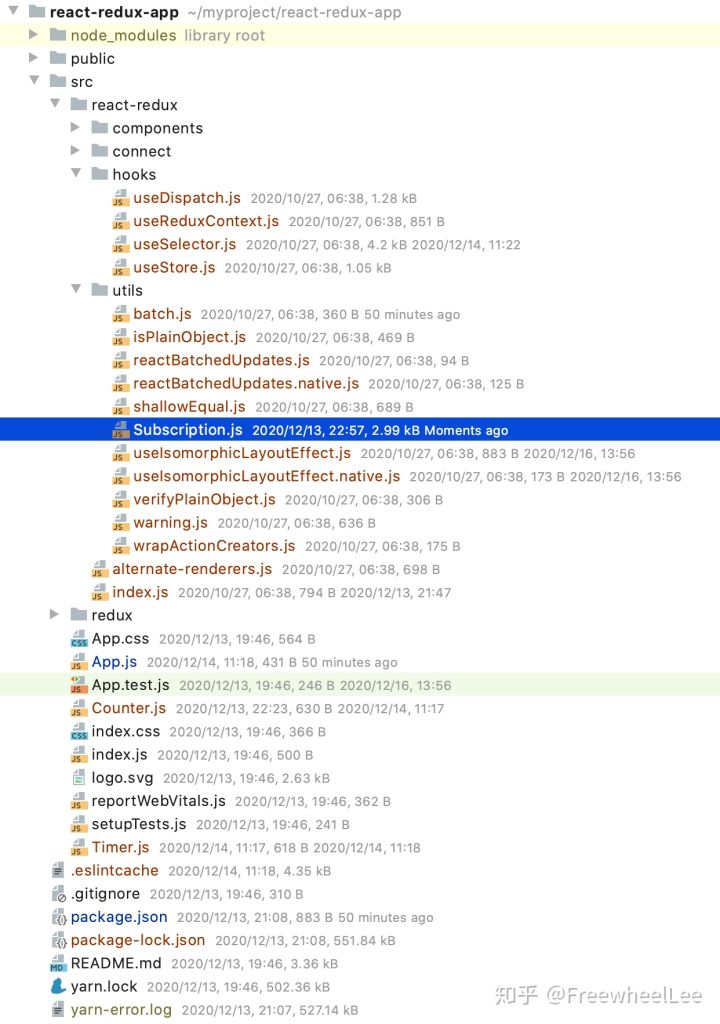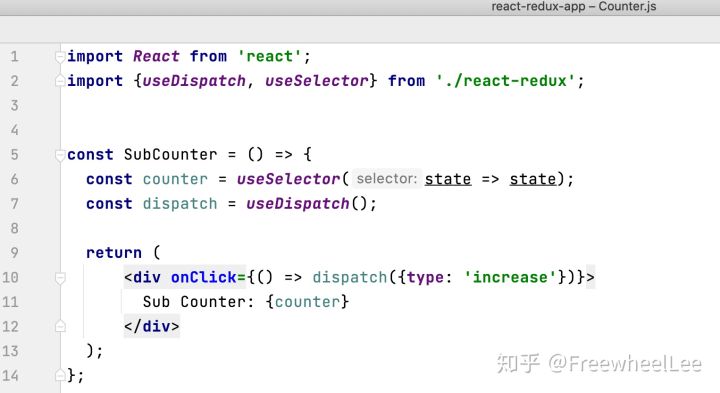相信不少初级程序员 / 学生 对读源码有一定的困难和心理压力,事实上,读懂源码并没有想象中那么困难。
本文将以阅读react-redux的源码为案例,分享一些读源码的小技巧。
读源码前该做什么
读源码前一定要沐浴更衣,焚香净手,冥想半小时~~~

手动狗头 /doge
读源码前,必须先了解这个库的基本背景知识:
- 它解决了什么问题
- 基本的使用方法
有了这些背景知识,才容易找到阅读源码的切入点,更容易理解源码的意图。
以 react-redux 为例,查看源码前,我们先看看 react-redux 是什么,它的基本使用方法。
react-redux 简介
什么是react-redux?
React Redux is the official React binding for Redux. It lets your React components read data from a Redux store, and dispatch actions to the store to update data.
事实上,redux只是一个单纯的JavaScript状态管理库,跟react并没有直接联系,在react代码中也难以直接使用。
而 react-redux 就是一座连接了 redux 和 react 的桥梁,它可以让React组件从 Redux store 中读取数据/状态 和 dispatch action 到 Redux store 中更改数据/状态。
在 react-redux 官方文档Quick Start中,基本使用方法如下
先使用 Provider 包裹住 React App 的根组件
import React from 'react'
import ReactDOM from 'react-dom'
import { Provider } from 'react-redux'
import store from './store'
import App from './App'
const rootElement = document.getElementById('root')
ReactDOM.render(
<Provider store={store}>
<App />
</Provider>,
rootElement
)
使用 connect 函数,连接组件到 Redux store
import { connect } from 'react-redux'
import { increment, decrement, reset } from './actionCreators'
// const Counter = ...
const mapStateToProps = (state /*, ownProps*/) => {
return {
counter: state.counter
}
}
const mapDispatchToProps = { increment, decrement, reset }
export default connect(
mapStateToProps,
mapDispatchToProps
)(Counter)
此外,react-redux 也支持 Hooks (Hooks | React Redux )
useSelector Hook
import React from 'react'
import { useSelector } from 'react-redux'
export const CounterComponent = () => {
const counter = useSelector(state => state.counter)
return <div>{counter}</div>
}
useDispatch Hook
import React from 'react'
import { useDispatch } from 'react-redux'
export const CounterComponent = ({ value }) => {
const dispatch = useDispatch()
return (
<div>
<span>{value}</span>
<button onClick={() => dispatch({ type: 'increment-counter' })}>
Increment counter
</button>
</div>
)
}
到目前为止,我们了解了 react-redux 的基本背景知识。
根据 基本使用方法,我们可以从 Provider 作为阅读react-redux 的切入口。
读源码时不要急于纠结细节,先总后分,先整体后局部
阅读 react-redux Provider 源码 (版本 v7.2.2)
import React, { useMemo, useEffect } from 'react'
import PropTypes from 'prop-types'
import { ReactReduxContext } from './Context'
import Subscription from '../utils/Subscription'
// 接收三个参数,第一个是 redux store 的引用,第二个参数明显是可选的(比如上面基本用法里并没有传入 context
function Provider({ store, context, children }) {
// 使用了 useMemo 缓存
const contextValue = useMemo(() => {
// 这边使用了一个内部自定义类 Subscription ,先不着急查看对应的源码,先看 Provider 的剩余代码
const subscription = new Subscription(store)
subscription.onStateChange = subscription.notifyNestedSubs
// 返回一个对象
return {
store,
subscription,
}
}, [store])
// 又用了一个 useMemo 缓存
const previousState = useMemo(() => store.getState(), [store])
useEffect(() => {
const { subscription } = contextValue
subscription.trySubscribe() // 根据变量名和方法名,这边尝试订阅(大概率是订阅 redux store 的变化)
if (previousState !== store.getState()) {
subscription.notifyNestedSubs()
}
return () => {
subscription.tryUnsubscribe()
subscription.onStateChange = null
}
}, [contextValue, previousState])
// 如果参数 context 是false值,就使用默认的 ReactReduxContext
const Context = context || ReactReduxContext
// 划重点:这个用法很明显就是 React Context
return <Context.Provider value={contextValue}>{children}</Context.Provider>
}
阅读 Provider 源码时,发现有个内部自定义类 Subscription ,因为Provider整体源码并不多,我们可以先看完 Provider 整体代码,而不着急查看 Subscription 类的源码。
看完Provider整体代码后,可以简单概况为:
- Provider 利用了React Context (不了解 context 的同学请参考官方文档 Context – React )
- 使用了 useMemo 缓存了 redux store 引用 和 自定义类 Subscription 的实例
- 使用 useEffect 做订阅和取消订阅操作
整体解读了 Provider 源码后,我们就可以开始阅读 Subscription 类的源码了
import {getBatch} from './batch'
// 源码中的注释
// encapsulates the subscription logic for connecting a component to the redux store, as
// well as nesting subscriptions of descendant components, so that we can ensure the
// ancestor components re-render before descendants
export default class Subscription {
constructor(store, parentSub) {
this.store = store; // 存放 redux store 的引用
this.parentSub = parentSub; // 父级订阅
this.unsubscribe = null // 取消订阅的方法的引用
this.listeners = nullListeners // 监听器链表 —— 随后会解读
this.handleChangeWrapper = this.handleChangeWrapper.bind(this)
}
// 添加嵌套订阅
addNestedSub(listener) {
this.trySubscribe() // 确保实例本身已经订阅了
return this.listeners.subscribe(listener) // 加入监听器链表
}
// 通知监听器链表中的所有监听器
notifyNestedSubs() {
this.listeners.notify()
}
handleChangeWrapper() {
// 当这个Subscription实例有onStateChange方法时就触发该方法
if (this.onStateChange) {
this.onStateChange()
}
}
isSubscribed() {
return Boolean(this.unsubscribe)
}
// 尝试订阅
trySubscribe() {
if (!this.unsubscribe) { // 避免重复订阅
// 划重点:当这个Subscription实例有上一级的订阅时,往上一级的订阅中添加子订阅
// 划重点:否则就直接在 redux store 中订阅
this.unsubscribe = this.parentSub
? this.parentSub.addNestedSub(this.handleChangeWrapper)
: this.store.subscribe(this.handleChangeWrapper)
// 懒加载 —— 仅当成功调用 trySubscribe 时才创建 监听器链表 —— 随后会解读为什么是链表
this.listeners = createListenerCollection()
}
}
// 尝试取消订阅
tryUnsubscribe() {
if (this.unsubscribe) {
this.unsubscribe()
this.unsubscribe = null
this.listeners.clear()
this.listeners = nullListeners
}
}
}
// 源码中,下面的代码是处于开头的,为了解读起来更好理解,我搬到结尾
// 一个无实现的监听器“链表” —— 作为Subcription实例中listeners的初始值
const nullListeners = {
notify() {
}
}
// 工厂方法 —— 创建一个监听器链表结构
function createListenerCollection() {
const batch = getBatch() // 获取批量更新的策略函数 —— react 和 react-native 不同
// 一个双向链表结构
let first = null // 链表头
let last = null // 链表尾
return {
clear() {
first = null
last = null
},
notify() {
batch(() => {
let listener = first
while (listener) { // 遍历链表,触发回调
listener.callback()
listener = listener.next
}
})
},
get() { // 以数组形式返回监听器链表
let listeners = []
let listener = first
while (listener) {
listeners.push(listener)
listener = listener.next
}
return listeners
},
// 订阅,即新增监听器
subscribe(callback) {
let isSubscribed = true
// 构建新监听器,置于链表结尾
let listener = (last = {
callback,
next: null,
prev: last, // 链表结尾
})
if (listener.prev) {
listener.prev.next = listener
} else {
first = listener
}
// 返回取消订阅的方法
return function unsubscribe() {
if (!isSubscribed || first === null) return
isSubscribed = false
if (listener.next) {
listener.next.prev = listener.prev
} else {
last = listener.prev
}
if (listener.prev) {
listener.prev.next = listener.next
} else {
first = listener.next
}
}
},
}
}
根据源码,我们发现了以下几点:
- Subscription作为工具类,在底层调用了 redux store 的 subscribe 方法
- Subscription 的属性 listeners 维护了一个双向链表结构,用于支持嵌套的订阅
读源码时发现疑问,可以(在源码里)做实验验证自己的想法
阅读 Subscription 源码时,最让我困惑的是它的嵌套订阅设计
- 什么时候会发生嵌套订阅?
- 一个父组件监听了redux后,它的子组件如果也监听redux,那么子组件的订阅是父组件订阅的子级吗?
读源码时发现疑问时,通常有两种做法:
- 继续精读各部分代码,尝试理解 —— 通常比较难,比较费脑细胞
- 在源码里做实验验证自己的想法 —— 结果通常比较直观,但是不一定能直接理解,常用作辅助的证据
读者可能会问,怎么在源码里做实验呢?
其实步骤很简单:
- 把三方库的源码 git clone 到本地
- 使用 create-react-app 创建一个 react 项目
- 把三方库的源码复制到我们的 react 项目里
- 直接从本地 import 三方库来使用
上截图

react-redux-app 是我自己创建的react app,我把 react-redux 的源码复制粘贴到了 src 下 的 react-redux 文件夹

注意,在使用 react-redux 时的 import 语句是直接从本地 import
import {useDispatch, useSelector} from './react-redux';
接下来,只要在本地的 react-redux 文件夹里“魔改”源码就能做实验了。
我在 Subscription.js 里createListenerCollection() 函数里添加了一个 length() 方法
length() { // 计算当前链表的长度
let listener = first;
let counter = 0;
while (listener) {
counter++;
listener = listener.next;
}
return counter;
},
并在 subscribe 方法里输出日志
subscribe(callback) {
console.log('createListenerCollection subscribe');
let isSubscribed = true
let listener = (last = {
callback,
next: null,
prev: last,
})
if (listener.prev) {
listener.prev.next = listener
} else {
first = listener
}
console.log('current length ' + this.length());
return function unsubscribe() {
if (!isSubscribed || first === null) return
isSubscribed = false
if (listener.next) {
listener.next.prev = listener.prev
} else {
last = listener.prev
}
if (listener.prev) {
listener.prev.next = listener.next
} else {
first = listener.next
}
}
},
最后,在这个测试 React APP 里写了几个嵌套的组件
Counter.js
import React from 'react';
import {useDispatch, useSelector} from './react-redux';
const SubCounter = () => {
const counter = useSelector(state => state);
const dispatch = useDispatch();
return (
<div onClick={() => dispatch({type: 'increase'})}>
Sub Counter: {counter}
</div>
);
};
const Counter = () => {
const counter = useSelector(state => state);
const dispatch = useDispatch();
return (
<div>
<div onClick={() => dispatch({type: 'increase'})}>
Counter: {counter}
</div>
<br/>
<SubCounter/>
</div>
);
};
export default Counter;
Timer.js
import React from 'react';
import {useDispatch, useSelector} from './react-redux';
const SubTimer = () => {
const counter = useSelector(state => state);
const dispatch = useDispatch();
return (
<div onClick={() => dispatch({type: 'increase'})}>
Sub Timer: {counter}
</div>
);
};
const Timer = () => {
const counter = useSelector(state => state);
const dispatch = useDispatch();
return (
<div>
<div onClick={() => dispatch({type: 'increase'})}>
Timer: {counter}
</div>
<br/>
<SubTimer/>
</div>
);
};
export default Timer;
App.js
import store from './redux/store'
import {Provider} from './react-redux';
import './App.css';
import Counter from './Counter';
import Timer from './Timer';
function App() {
return (
<Provider store={store}>
<div className="App">
<header className="App-header">
<Counter/>
<br/>
<Timer/>
</header>
</div>
</Provider>
);
}
export default App;
在 App 组件中,将会分别渲染一个 Counter组件 和 一个Timer组件, 而 Counter组件Timer组件里除了自身订阅了 redux ,还有子组件 SubCounter 和 SubTimer 也会订阅redux
效果如下
我在前文提到的疑问
一个父组件监听了redux后,它的子组件如果也监听redux,那么子组件的订阅是父组件订阅的子级吗?
如果是如此的话,那么运行 App 后日志中应该会(至少)两次输出
createListenerCollection subscribe current length 1
而事实上,打印的结果是

也就是说,以上4个订阅了redux的组件(即 使用了4次 useSelector) 背后产生了4个监听器并且处于同一个监听器链表中!
因此上面的疑问的答案是否定的 —— 订阅的父子级关系与组件的父子级不相关。
事实上,在一般情况下(即 Provider 里不设 context 属性) ,嵌套订阅只发生一次。
还记的 Provider 源码里见到的
const subscription = new Subscription(store)
吗? 这一级是父级订阅。
之后使用useSelector 产生的所有的订阅都是它的子级订阅,具体细节可以查看以下源码:
在读 react-redux 源码时发现的一些有趣的点
在阅读 useSelector.js 时,发现 useSelectorWithStoreAndSubscription 这个内部hook 非常有意思,解读如下
const refEquality = (a, b) => a === b
function useSelectorWithStoreAndSubscription(
selector, // selector函数
equalityFn, // 判断前后state是否相等的策略函数(参考设计模式中的策略模式)
store, // redux store 引用
contextSub // Context 中的 Subscription 实例
) {
// 一个 特殊的 useReducer 的用法,调用 forceRender 时会触发组件重新渲染!
// 拓展知识点:useState 底层实际调用了 useReducer 才导致了重新渲染
const [, forceRender] = useReducer((s) => s + 1, 0)
const subscription = useMemo(() => new Subscription(store, contextSub), [
store,
contextSub,
])
const latestSubscriptionCallbackError = useRef()
const latestSelector = useRef()
const latestStoreState = useRef()
const latestSelectedState = useRef()
const storeState = store.getState()
let selectedState
try {
if (
selector !== latestSelector.current ||
storeState !== latestStoreState.current ||
latestSubscriptionCallbackError.current
) {
selectedState = selector(storeState)
} else {
selectedState = latestSelectedState.current
}
} catch (err) {
if (latestSubscriptionCallbackError.current) {
err.message += `\nThe error may be correlated with this previous error:\n${latestSubscriptionCallbackError.current.stack}\n\n`
}
throw err
}
// useIsomorphicLayoutEffect 根据当前环境是 web 还是 react native 有不同的实现
// 可以参考源码 https://github.com/reduxjs/react-redux/blob/v7.2.2/src/utils/useIsomorphicLayoutEffect.js 和 https://github.com/reduxjs/react-redux/blob/v7.2.2/src/utils/useIsomorphicLayoutEffect.native.js
useIsomorphicLayoutEffect(() => {
latestSelector.current = selector
latestStoreState.current = storeState
latestSelectedState.current = selectedState
latestSubscriptionCallbackError.current = undefined
})
useIsomorphicLayoutEffect(() => {
function checkForUpdates() {
try {
const newSelectedState = latestSelector.current(store.getState())
if (equalityFn(newSelectedState, latestSelectedState.current)) {
// 如果根据 equalityFn 判断前后的 state 不变,就不做任何事,直接返回
return
}
latestSelectedState.current = newSelectedState
} catch (err) {
// we ignore all errors here, since when the component
// is re-rendered, the selectors are called again, and
// will throw again, if neither props nor store state
// changed
latestSubscriptionCallbackError.current = err
}
// 如果根据 equalityFn 判断前后的 state 发现变化,则重新渲染
forceRender()
}
subscription.onStateChange = checkForUpdates
subscription.trySubscribe()
checkForUpdates()
return () => subscription.tryUnsubscribe()
}, [store, subscription])
return selectedState
}
还有另一个有趣的现象 —— 在 react-redux 源码中,我发现 connect 相关的源码非常复杂,相反,而Hooks 相关源码简单清晰很多。这是不是从某种程度上说明 React Hooks 的确比 HOC 更好/先进呢?
这边有篇讨论使用 react-redux时该用过 connect HOC 还是 hooks 的文章(英文),有兴趣的读者可以阅读看看 Blogged Answers: Thoughts on React Hooks, Redux, and Separation of Concerns
总结
授人予鱼,不如授人予渔。今天这边文章分享了我自己阅读源码的一些技巧,希望对你们有帮助,增强你们阅读源码的信心。如果你们觉得本文对你们有启发,有帮助,欢迎点赞、喜欢、收藏!
相关链接:
Blogged Answers: Thoughts on React Hooks, Redux, and Separation of Concerns